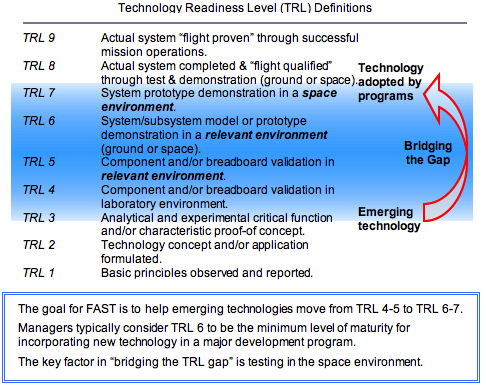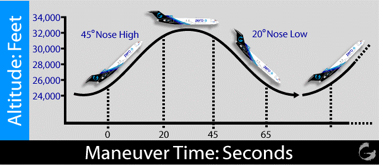| |

|
|
 |
| |
 |
| |
Facilitated Access to the Space Environment for Technology Development and Training (FAST)
Providing opportunities for emerging technologies to perform testing in the space environment. Testing technologies that:
- support NASA's missions but are not mature enough for adoption into major development programs (see Technology Maturity below)
- might not otherwise be tested due to lack of funding:
- SBIR/STTR contractors and other private companies
- SEED Fund companies
- Universities and research institutions
- NASA projects in early development

The current focus is on testing in micro-gravity, reduced-gravity or variable-gravity conditions on parabolic aircraft flights and later on suborbital and orbital flights.
A second objective of FAST is to utilize commercially available flight test capabilities. (see Parabolic Flight Contract below)
September 15, 2008: NASA Uses Commercial Microgravity Flight Services For First Time
RELEASE: 08-232
NASA for the first time last week used microgravity research flights aboard commercially-owned aircraft to test hardware and technologies.
+ Read More
Comments From FAST Participants
On September 9 and 10, 2008, five NASA SBIR companies tested technologies on-board the Zero-Gravity Corporation aircraft in the inaugural flights of the FAST program. The aircraft flew parabolic trajectories to generate zero-gravity and lunar gravity conditions. Here are comments from some of the participants.
Pneumatic Mining Under Lunar Gravity Conditions
This was a great experience on both personal and research level. During our first day we performed preliminary tests and later that day did some trouble-shooting to improve measurements. Our second day was almost perfect. We achieved 90% of the test requirements and we were on our way to achieve 100% on the 3rd and 4th days. We will have to run some tests at 1g to determine the effect of lower g's, but from the first impression it looks like lower gravity does have a positive effect on the efficiency of pneumatic soil transfer. Having this two-day experience of reduced-g flights, we are now much more experienced and know exactly how to prepare ourselves and experiments for the next flights.
Kris Zacny
Honeybee Robotics, New York, NY
Nanofluid Coolant Testing
During our second flight we obtained high quality data that showed that the thermal conductivity of nanofluids remained high at all gravity conditions measured. This was the validation that we were looking for and will increase the technology readiness level of our technology.
Steven Oldenburg
nanoComposix, Inc., San Diego, CA
Microgravity Flight-testing of Self-deploying Shells
During one day of testing, Mevicon Inc. measured the deployment of about 25 different roll stowed shells in various gravity conditions. Parameters such as shell prescription, material, and repeatability were assessed. The data, when compared to ground test results for similar shells, will help us refine models by including the effect of the absence of gravity on our membrane shell deployment, thereby preparing the way for their potential use in space applications. It was also seen that 0.3m shells maintained their shape even when fully deployed in the 2-G environment.
We thought both the Zero-G folks and the NASA folks were very professional and helpful. If we get the chance to fly again, we would really welcome that. Now that Jim and Travis were actually in the microgravity environment we have already envisaged relatively minor changes to the test approach that would enhance throughput.
Eric Flint
Mevicon Inc., Sunnyvale, CA
Virtual Sensor Test Instrumentation Operations
The experience is exciting and helping us tremendously to confirm the operation capabilities of the smart sensors. We also gained new knowledge for designing our next phase product in order to enhance transmission and sensor interfaces.
Ray Wang
Mobitrum Corporation, Silver Spring, MD
Cost-Sharing: For competitively selected projects, the FAST program will generally cover the cost of the parabolic flight. Experimenters will be expected to cover their expenses for preparing the experimental hardware and traveling to the airfield where the flight will occur.
Criteria: Competitive selection of proposed experiments will be based on the following criteria:
- Relevance of the technology to the needs of NASA missions
- Likelihood that the parabolic flight test will advance technological maturity
- Readiness of the project and hardware for space-environment testing
| |

|
|
Future Suborbital Flight Testing:
As commercial suborbital spaceflight capabilities emerge, the FAST program will seek to use those flights for technology testing.
 |
|
 |
Announcements
Selections for Initial FAST Flight Test Opportunity
NASA's Innovative Partnerships Program has selected seven Small Business Innovation Research (SBIR) companies to participate in the initial phase of FAST reduced-gravity test flights in early September 2008. The selection for the first round of flights was limited to companies that already had SBIR contracts with NASA. In the future, the competition will be extended to any companies and laboratories working in partnerships on technology of value to NASA's missions.
The Zero-Gravity Corporation will conduct the flights as a commercial service to NASA. The Zero-G Corporation contract, which is managed by the NASA Glenn Research Center, is part of an effort to expand NASA's use of commercial services. The flights will be conducted from Ellington Field in Houston, Texas and the Johnson Space Center and Glenn Research Center will provide technical support to the participating companies.
The flights in early September will involve the following projects and companies:
- Vacuum-Compatible Multi-Axis Manipulator/Machining Center (M/MC) for Long-Duration Space Missions
Beck Engineering, Inc. Port Orchard, WA
http://sbir.gsfc.nasa.gov/SBIR/abstracts/06/sbir/phase1/SBIR-06-1-X7.01-9703.html
NASA Langley SBIR, supporting ESMD and SOMD technology needs.
Demonstrating a capability for in-situ machining of parts during space missions and on the surface of the Moon or Mars (intend to fly with zero-g, 1/6g and 1/3g conditions).
- Investigation of Pneumatic Mining System Under Lunar Gravity Conditions
Honeybee Robotics Spacecraft Mechanisms Corporation, New York, NY
http://sbir.gsfc.nasa.gov/SBIR/abstracts/06/sbir/phase1/SBIR-06-1-X4.03-8139.html
NASA KSC SBIR, supporting ESMD and SMD technology needs.
Novel method using air to excavate lunar material for processing or surface construction.
- Aircraft SensorLogger
Metis Design Corporation, Cambridge, MA
http://sbir.gsfc.nasa.gov/SBIR/abstracts/05/sbir/phase1/SBIR-05-1-A1.04-9399.html
NASA DFRC SBIR, supporting ARMD and SOMD technology needs.
Device for dynamic in-flight measurements.
- Microgravity Flight Testing of Passively Self Deploying Roll Stowed Shells
Mevicon Inc., Sunnyvale CA
http://sbir.gsfc.nasa.gov/SBIR/abstracts/05/sbir/phase1/SBIR-05-1-S6.02-8499.html
NASA GSFC SBIR, supporting ARMD and SMD technology needs.
Deployment of structures for antennas, mirrors, solar collectors, etc.
- Virtual Sensor Test Instrumentation
Mobitrum Corporation, Silver Spring, Maryland
http://sbir.gsfc.nasa.gov/SBIR/abstracts/05/sbir/phase1/SBIR-05-1-O2.02-9889.html
NASA SSC SBIR, supporting ARMD and SMD technology needs.
Device to collect and share in-flight data measurements in a network.
- Nanofluid Coolants
nanoComposix, Inc., San Diego, CA
http://sbir.gsfc.nasa.gov/SBIR/abstracts/04/sbir/phase1/SBIR-04-1-E1.07-9391.html
NASA MSFC SBIR, supporting ESMD, SOMD and SMD technology needs.
Coolant fluid with suspended nano-particles that enhance thermal conductivity.
- Constant-Force-Exercise Sled
Valeo Human Performance, LLC, Houston, TX
http://sbir.gsfc.nasa.gov/SBIR/abstracts/00/sbir/phase1/SBIR-00-1-10.03-8523.html
NASA JSC SBIR, supporting SOMD and ESMD technology needs.
Simple, small human exercise sled for use in spaceflight.
Future Calls for Proposals
In Summer 2008, we expect to issue a call for proposals from the broad research community for flights to occur in 2009. This call will not be limited to SBIR companies. The details of that call will be provided at this website location.
Technology Maturity

Parabolic Aircraft Flight Testing
NASA has been flying parabolic flights on NASA-owned KC-135 and C-9B aircraft for decades out of Ellington Field under the management of the Johnson Space Center's Reduced Gravity Office. Those flights have made numerous contributions to scientific advancement and technology development.
The aircraft can provide about 25 seconds of near-zero-gravity conditions during each parabolic maneuver. It can provide variable gravity levels between zero and one including 0.16 g for lunar conditions and 0.38 g for Mars conditions. An increased gravity level of up to 1.8 g can be provided for up to one minute.

Parabolic Flight Contract
NASA awarded a contract to the Zero Gravity Corporation in January 2008 to provide commercial parabolic aircraft flights to simulate variable gravity environments for research and development work. The FAST program will utilize this commercial service. ZERO-G will provide up to 20 NASA flight weeks per year. NASA has exclusive use during these flight weeks. Each flight includes 40-60 parabolic trajectories. NASA Flight Weeks will generally be conducted out of Ellington Field in Houston and the Glenn Research Center in Cleveland.
Related Links
NASA JSC Reduced Gravity Office
http://jsc-aircraft-ops.jsc.nasa.gov/Reduced_Gravity/index.html
NASA Experiment Design Requirements and Guidelines
http://jsc-aircraft-ops.jsc.nasa.gov/Reduced_Gravity/docs/AOD_33897.pdf
NASA SBIR/STTR Program
http://sbir.gsfc.nasa.gov/SBIR/SBIR.html
| |

|
|
Space Experiment Rack Receives Flight Time
A new space experiment rack under development by Kennedy Space Center and Space Florida recently received some flight time.
+ View PDF
|
The Innovative Partnerships Program (IPP) and Strategic Capabilities Assets
Program (SCAP) are offering an opportunity for companies with NASA SBIR/STTR
Phase I and II contracts to conduct reduced-gravity testing of their
technology aboard parabolic aircraft flights. Technologies must be within
the TRL 4-6 range and should be ready for microgravity environment testing
in the June to September, 2008 timeframe.
+ Read More
|
|

